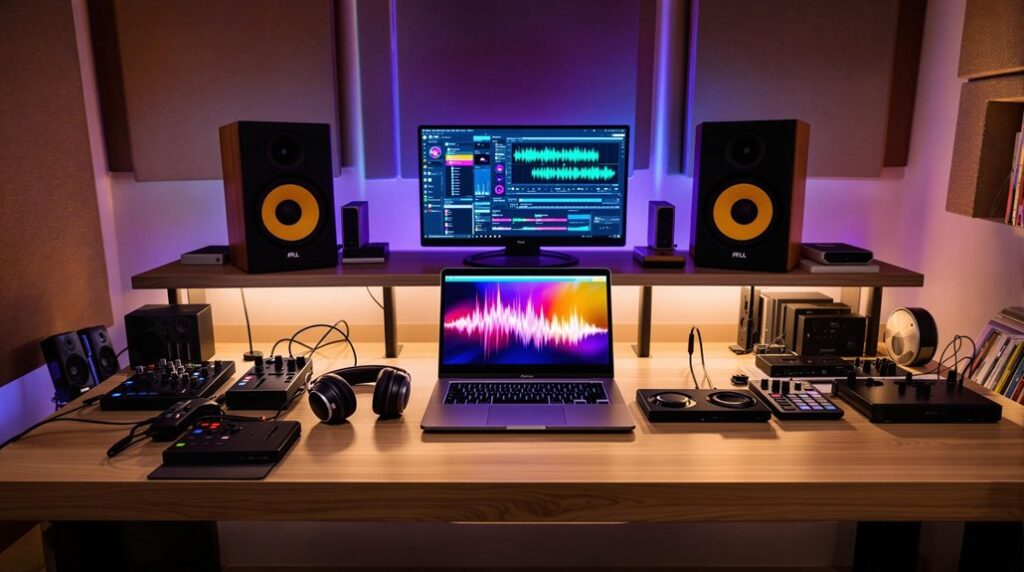To tame harsh highs in your mix, start by identifying problem frequencies, typically within the 2kHz to 8kHz range, using a spectrum analyzer. Employ a dynamic EQ like TDR Nova for precise, targeted adjustments, ensuring natural audio character. Use frequency-selective compression with multiband compressors to balance harsh highs without compromising the mix. Apply de-essers to control sibilant sounds, adjusting threshold and ratio settings for best vocal clarity. As a final touch, consider using tape saturation plugins to add warmth and cohesion. Explore these techniques thoroughly to finesse your mix with professional-level polish.
Key Takeaways
- Use a spectrum analyzer to visualize and identify harsh frequencies between 2kHz and 8kHz.
- Apply dynamic EQ for precise and targeted adjustments while maintaining the natural sound.
- Utilize frequency-selective compression to reduce harsh highs without compromising the mix balance.
- Implement de-essers to control sibilance in vocals and smooth out ‘s’ and ‘sh’ sounds.
- Add gentle high shelf EQ boosts and tape saturation for warmth and cohesion in the final mix.
Identifying Harsh Frequencies
To effectively identify harsh frequencies in your mix, focus on the mid to high range, typically between 2kHz and 8kHz, where ear fatigue and piercing sounds often originate. This frequency band is notorious for causing discomfort if not properly managed, especially in elements like vocals, cymbals, hi-hats, distorted guitars, and synth leads.
Start by using a spectrum analyzer or frequency analyzer. These tools provide spectrum visualization, which helps you see exactly where the problematic frequencies lie. By observing the real-time frequency spectrum, you can pinpoint specific peaks that might be causing harshness. This visual aid is essential in making informed adjustments rather than relying solely on your ears, which can be subjective and prone to fatigue.
Once you’ve identified the offending frequencies, the next step is to make pinpointing adjustments. This involves making precise cuts in the EQ to reduce those harsh peaks without affecting the overall balance of your mix. Remember, harsh highs often result from excessive sibilance, overly bright microphone placements, or over-boosting high frequencies during mixing.
Using Dynamic EQ
When dealing with harsh highs, dynamic EQs like MeldaProductions Dynamic EQ and TDR Nova offer a precision tool for making targeted adjustments without compromising the overall sound quality. These tools combine the capabilities of EQ and compression, allowing you to focus on specific frequency bands that contribute to harshness in your mix.
To effectively tame those harsh highs, set appropriate attack and release times. A high enough ratio guarantees transparency while dynamically adjusting problematic frequencies. This approach helps you retain the natural character of your audio, a key benefit of using dynamic EQs.
One of the primary benefits of dynamic EQs is their ability to perform creative frequency sculpting. By dynamically responding to the input signal, these tools only apply the necessary reduction when certain frequencies exceed a threshold, making them less intrusive than static EQ adjustments.
However, be mindful of their limitations; improper settings can lead to an unnatural sound or insufficient reduction of harshness.
Frequency-Selective Compression
Frequency-selective compression provides an effective method to target and reduce harsh highs without compromising the integrity of your entire mix. By honing in on specific frequency ranges, you can dynamically compress only the problematic frequencies, thereby preserving the overall balance and clarity of your mix. Band specific compression tools like Multiband Compressors or Dynamic EQs are invaluable for this purpose.
When implementing frequency-selective compression, start by identifying the harsh frequencies that need taming. Adjust the threshold and ratio settings for the targeted bands to control those harsh highs effectively. For instance, setting a lower threshold will make sure compression engages more readily, while a higher ratio will intensify the compression effect on those frequencies.
Employing band specific compression allows you to apply frequency focused dynamics to your mix. This means you can address the harsh highs without inadvertently affecting other frequency ranges, which is important for maintaining the sonic integrity of your mix. Utilizing these tools strategically can help you achieve a more polished and professional sound, ensuring that the high frequencies are controlled but still present and clear in the mix.
Applying De-Essers
De-essers effectively address harsh high frequencies by targeting and reducing sibilant sounds within the 2-10 kHz range, guaranteeing a smoother audio experience. In vocal processing, these specialized plugins dynamically control sibilance, which can often dominate and distort your mix. By focusing on ‘s’ and ‘sh’ sounds, de-essers lower their intensity without compromising the overall tonal quality.
When applying de-essers, start by identifying the problematic frequency range. Most de-essers provide controls like threshold, ratio, attack, and release settings. Set the threshold to detect unwanted sibilance and adjust the ratio to determine how much reduction is applied. Fine-tuning the attack and release times will help ensure the de-esser reacts swiftly to sibilant peaks but releases smoothly to maintain natural sound dynamics.
Incorporating de-essers into your mixing techniques not only enhances vocal clarity but also aids in instrument balancing. For instance, harshness in cymbals or high-pitched string instruments can be tamed, contributing to a more polished mix.
During audio mastering, a well-applied de-esser guarantees that high frequencies remain crisp yet controlled, avoiding listener fatigue. Master the use of de-essers, and you’ll achieve a professional, balanced sound.
Final Touches and Tweaks
As you approach the final stages of your mix, applying subtle adjustments like gentle high shelf EQ boosts and dynamic EQ can refine your sound, ensuring a polished and professional finish.
Start by gently boosting the high shelf EQ to add brightness without introducing harshness. This technique enhances the overall clarity while maintaining a smooth top end.
Next, consider using tape saturation plugins to bring warmth to your mix. Tape saturation smooths out harsh high frequencies, adding a pleasing analog character that makes your mix sound more cohesive. When applied judiciously, it can transform brittle highs into a warm, inviting presence.
Dynamic EQ is another tool to specifically target and tame harsh high frequencies. By setting a dynamic EQ to attenuate only when certain harsh frequencies exceed a threshold, you can control sibilance and piercing highs without affecting the rest of the spectrum.
Frequently Asked Questions
How to Get Rid of Harshness in a Mix?
To get rid of harshness in your mix, employ acoustic treatment for better room sound. Use soft clipping to gently reduce peaks. Combine EQ techniques and dynamic EQs with de-esser plugins, harmonic distortion, and specialized de-harshing tools.
How to Remove Harshness From a Vocal?
To remove harshness from a vocal, use de-essing techniques by adjusting the threshold and frequency range. Employ dynamic processing for precise control. Experiment with split-band mode and the audition feature to isolate and reduce harsh high frequencies.
How to Eq Harsh Sounds?
To EQ harsh sounds, use a Dynamic EQ to precisely target problematic frequencies. Adjust attack and release settings to mitigate harshness without sacrificing clarity. Address frequency masking by lowering competing frequencies, allowing the desired sound to shine.
How to Make Your Mic Less Harsh?
To make your mic less harsh, adjust the microphone placement slightly off-axis and use pop filters to reduce plosives. Experiment with different mic types and placements, and consider a de-esser and EQ adjustments for best results.
Conclusion
By identifying harsh frequencies and applying tools like dynamic EQ, frequency-selective compression, and de-essers, you’ll effectively tame harsh highs in your mix.
Each technique targets specific issues, ensuring a balanced and pleasant listening experience.
Always trust your ears and make final tweaks as necessary.
With these precise strategies, your mixes will sound polished and professional.
Remember, meticulous attention to detail in the high-frequency range can greatly enhance your overall mix quality.




